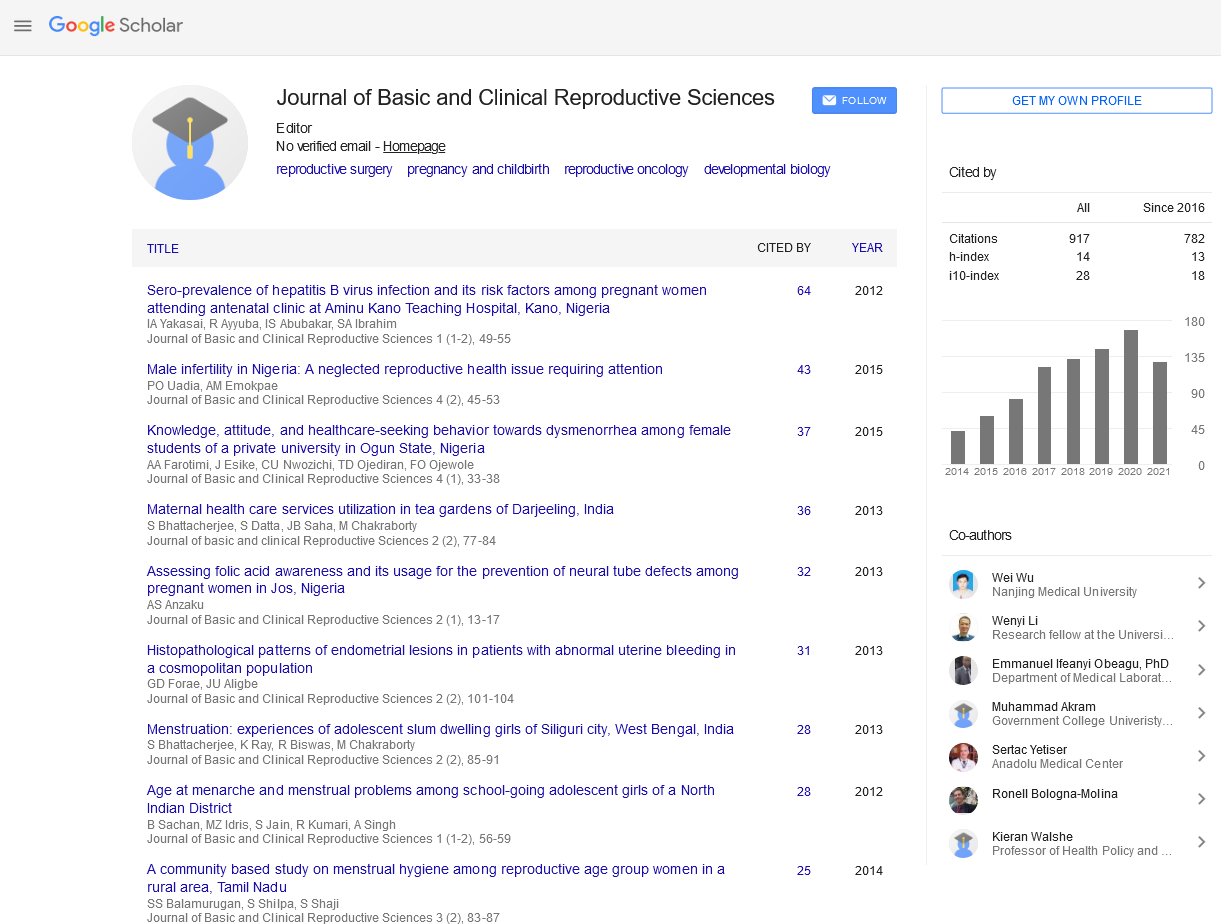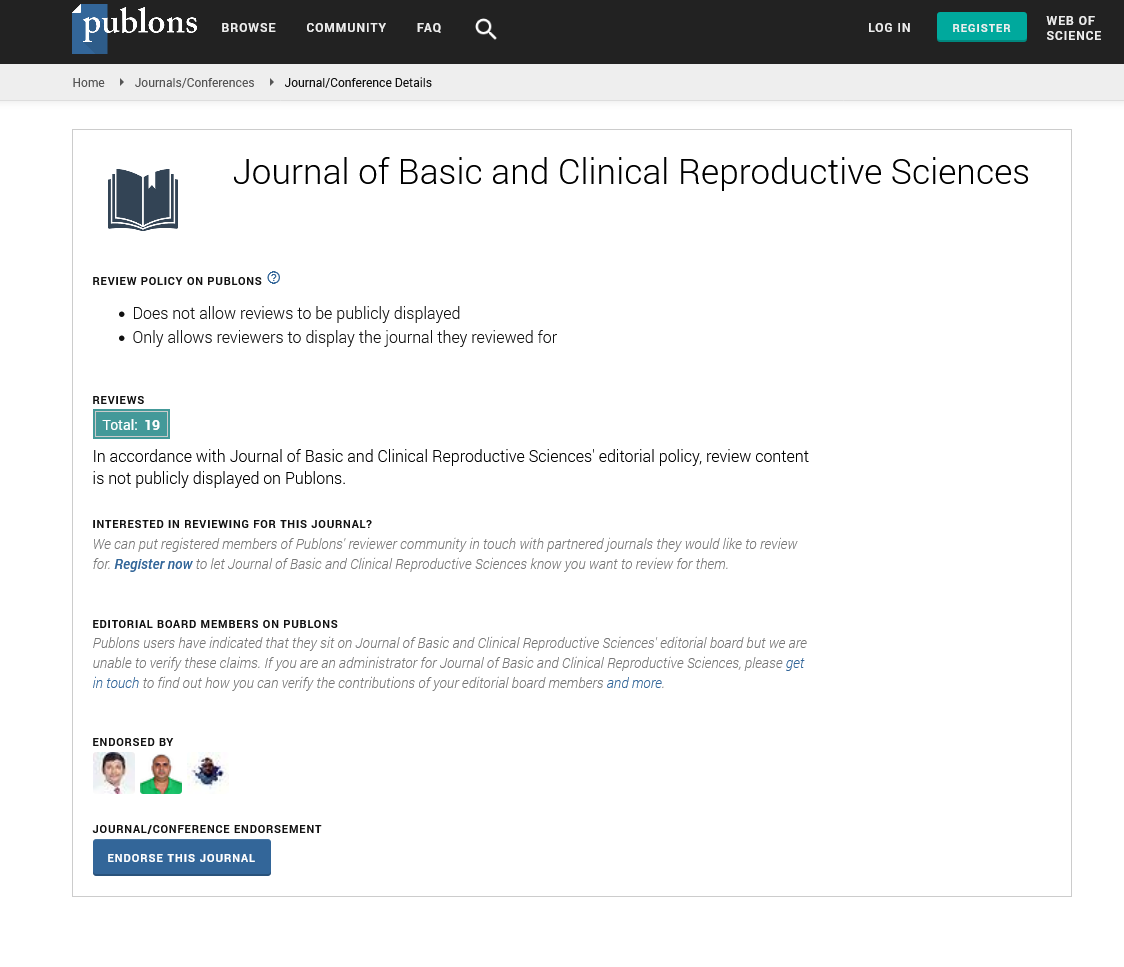Perspective - Journal of Basic and Clinical Reproductive Sciences (2024) Volume 13, Issue 3
The Impact of Stem Cell-Derived Secretomes on Reproductive Health: Potential Therapeutic Applications
Received: 20-May-2024, Manuscript No. JBCRS-24-143324; Editor assigned: 22-May-2024, Pre QC No. JBCRS-24-143324 (PQ); Reviewed: 05-Jun-2024 QC No. JBCRS-24-143324; Revised: 14-Jun-2024, Manuscript No. JBCRS-24-143324 (R); Published: 21-Jun-2024
This open-access article is distributed under the terms of the Creative Commons Attribution Non-Commercial License (CC BY-NC) (http://creativecommons.org/licenses/by-nc/4.0/), which permits reuse, distribution and reproduction of the article, provided that the original work is properly cited and the reuse is restricted to noncommercial purposes. For commercial reuse, contact reprints@pulsus.com
Description
Stem cells have developed as a basis of modern medical research, with their potential applications stretching across various domains, including reproductive medicine. Their unique ability to differentiate into multiple cell types provides promising avenues for addressing infertility, improving assisted reproductive technologies, and advancing our understanding of reproductive health. Stem cells are undifferentiated cells with the remarkable capacity to develop into different specialized cell types. They are categorized primarily into two types: Embryonic Stem Cells (ESCs) and Adult Stem Cells (ASCs). ESCs, derived from early-stage embryos, can differentiate into virtually any cell type, whereas ASCs, found in various tissues, are more limited but still capable of giving rise to several specialized cells relevant to specific tissues. Infertility is a global challenge affecting millions of individuals. Traditional treatments, such as In Vitro Fertilization (IVF), have made significant steps, but stem cells present new possibilities for overcoming infertility.
Oocyte and sperm production: One of the most exciting applications of stem cells in reproductive medicine is the potential to generate oocytes (egg cells) and sperm from stem cells. Research has demonstrated that ESCs can be coaxed into developing into germ cells, which are the precursors to eggs and sperm. This breakthrough could provide solutions for individuals with conditions leading to the loss of reproductive cells, such as premature ovarian failure or male infertility.
Ovarian and testicular tissue regeneration: Stem cells provide the potential to regenerate damaged ovarian and testicular tissues. For women undergoing chemotherapy, which often results in infertility, stem cell-based therapies might help preserve fertility by regenerating ovarian tissue. Similarly, for men with testicular damage or dysfunction, stem cells could aid in restoring normal sperm production.
Assisted Reproductive Technologies (ART) like IVF have revolutionized fertility treatment, but they still face challenges such as embryo implantation failures and poor egg quality. Stem cells might be used to generate high-quality oocytes for IVF, potentially improving success rates. Research into creating oocytes from stem cells could also provide a solution for women with reduced ovarian reserve or quality. Stem cells can help model early embryonic development, providing insights into the factors that contribute to embryo viability. This understanding can lead to better culture conditions and techniques that improve embryo quality and implantation success. For women with uterine abnormalities or conditions such as Asherman’s syndrome, stem cells can be employed to engineer or regenerate uterine tissue, improving the chances of successful implantation and pregnancy. Stem cell research provides valuable insights into the fundamental processes of reproductive development and disease. By studying stem cells, scientists can better understand the mechanisms underlying reproductive disorders and congenital conditions. Stem cells can be used to create models of reproductive disorders such as Polycystic Ovary Syndrome (PCOS) or endometriosis. These models help researchers investigate disease mechanisms and test new treatments in a controlled environment. Stem cells allow for the study of genetic mutations associated with reproductive diseases. By generating stem cell lines with specific genetic alterations, researchers can explore how these mutations affect reproductive development and function.
Conclusion
Stem cell applications in reproductive medicine face several challenges such as ethical concerns, particularly with the use of ESCs, technical hurdles in differentiating stem cells into functional reproductive cells, and the need for safety evaluations to avoid potential risks such as tumor formation. Advancements in stem cell technology and research hold the potential to revolutionize reproductive medicine. As techniques improve and our understanding deepens, stem cells may become integral to not only treating infertility but also advancing reproductive health and enhancing the quality of life for individuals facing reproductive challenges. Stem cells provide transformative potential for reproductive medicine, from generating gametes and regenerating reproductive tissues to enhancing ART and understanding reproductive diseases. Continued research and development in this field could bring about ground-breaking changes in how we approach infertility and reproductive health, providing hope and new possibilities for countless individuals and couples worldwide.


